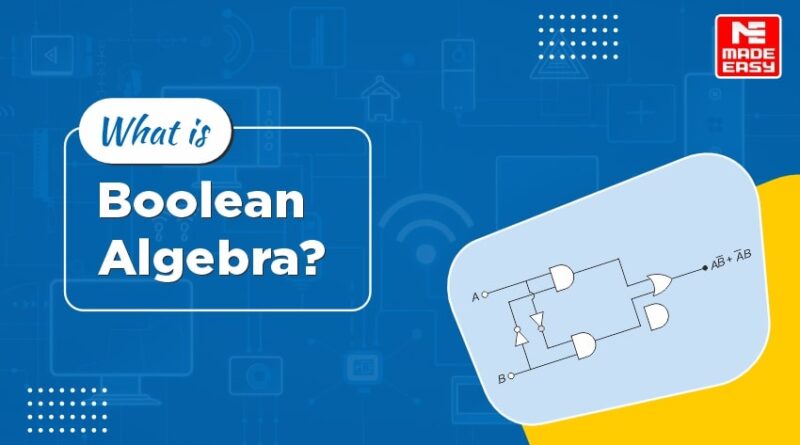What is Boolean algebra?
The binary operations performed by any digital circuit with the set of elements 0 and 1 are called logical operations or logic functions. The algebra used to symbolically represent the logic function is called Boolean algebra. It is a two state algebra invented by George Boole in 1854. Thus, a Boolean algebra is a system of mathematics logic for the analysis and designing of digital systems.
A variable or function of variables in Boolean algebra can assume only two values, either a ‘0’ or a ‘1’. This algebra deals with the rules by which the logical operations are carried out.
Here, a digital circuit is represented by a set of input and output symbols, and the circuit function is expressed as a set of Boolean relationships between the symbols.
Key points:
- Laws of Boolean Algebra
- Boolean Algebraic Theorem
- Karnaugh Map
- Logic Gates
- Basic Gates
- The NAND gate
- The NOR gate
- The Exclusive-OR Gate (ex-OR)
- The Exclusive NOR (ex-NOR) Gate
- Realization of Logic Gates Using Universal Gates
- Combinational and Sequential circuits
- Adders and Subtractors
- Code Converters
- Multiplexers
- Counters
- 8085 Microprocessor
1. Boolean algebra in Digital Electronics:
Boolean algebra is the language of digital electronics, as it lays the foundation for operating, thinking, and interacting with digital electronics and humans. Boolean algebra provides a mathematical framework to describe and simplify the operation of digital circuits. Let us look at the roles of Boolean algebra in digital electronics.
Designing of Logic Gates:
Logic Gates are the fundamental building blocks in digital circuits. Boolean algebra helps in the design of logic gates.
Simplification of logic expression:
Boolean algebra laws like De Morgan’s law are used in simplifying complex logic expressions.
Truth table and logic gate analysis:
Boolean algebra helps in the conversion of logic gates’ truth tables into Boolean expressions and vice versa, which helps in the analysis of logic gates.
Memory and Data Handling:
Boolean algebra helps in the design of memory-storing elements like flip-flops and registers.
2. Binary Values:
Binary values of basic values that are used in the binary number system. The binary number system is the basis of all digital electronics systems. The binary number system has base 2, which means it has two base numbers, viz., 0 and 1. These base numbers are called bits. Bit “0” represents the off, false, or low voltage, whereas bit “1” represents the on, true, or high voltage.
In the binary system, a group of “four bits” is called a “nibble,” and a group of “eight bits” is called a “byte.” The computer stores all the information in terms of these two bits.
3. Logic Operations:
In Boolean algebra, all the algebraic functions performed are logical. These represent logical operations. The AND, OR, and NOT are the basic operations that are performed in Boolean algebra. In addition to these operations, there are some derived operations such as NAND, NOR, EX-OR, EX-NOR that are also performed in Boolean algebra.
4. Circuit Analysis and Simplification:
Circuit analysis in digital electronics is the understanding of how digital circuits work. This is done by examining the input, logic gates, connections, and the outputs. Circuit analysis is done to understand the behavior of circuit logically by writing down Boolean expression, creating truth table or simulating its behavior. Circuit simplification helps in the reduction of complex digital circuit to simplest form without changing its functionality.
5. Truth Tables:
A truth table is the table showing all possible input connections of logic gates and their corresponding outputs. The truth table holds a very important place in digital electronics, as it helps the engineers and designers to understand how the circuit will behave under all possible input conditions.
Let us have a look at how truth tables play an important role in digital electronics:
- A truth table shows all various possible cases of input-output connection and is used in the simplification of Boolean logic to reduce the number of logic gates.
- A truth table helps in the design of logic gates. Before designing any digital circuit, a truth table helps in determining its output for various input connections.
- A truth table helps in analyzing the Boolean expression by comparing two different expressions to see if they are logically equivalent and giving the same output for every input.
6. Digital Circuit Design:
Digital circuit design is the process of designing electronic circuit to handle digital signal. These digital signal have two state of “0” and “1”. Various logic gates are used in designing digital circuit.
7. Switching Theory:
Switching theory is the framework meant for analyzing various digital circuits that uses switches to store information. These switches are transistors which are made up of logic gates. The name switching theory comes from the fact that these logic gates made transistor control the flow of signal just like a light switch control the flow of electricity.
8. Programming and Computer Science:
Programming in computer science is the process of writing instructions in various computer programming languages like C, Java, Python, etc. that a computer can understand and execute.
9. Microcontroller Design:
Microcontrollers are small chips used to control electronic devices and systems. Microcontrollers are like the brain of electronic systems and devices having various parts like processors, input-output pins, memory etc all built on one chip. Some examples of microcontrollers are 8051, AVR, PIC series etc.
Online Courses for Boolean algebra (EE):
If you want to learn about boolean algebra through Online course, click on the given below links:
- Live Online Foundation Course for ESE, GATE, and SES 2026
- Live-Online Course for GATE 2026 Data Science & Artificial Intelligence
- Live Online Foundation Course for GATE + SES (GS)
- Tablet Course for ESE + GATE 2026-27
- Tablet Curse for GATE 2026-27
National Program for Technology Enhanced Learning, popularly known as NPTEL offers multiple course of digital electronics. The link of some of the courses are given below. Those who want to know more about NPTEL, its courses and certification exam can visit here.
- Digital Electronic Circuits
- Digital Circuits and Systems
- Digital Circuits & Systems
- Digital System design with PLDs and FPGAs
- Digital Systems Design
FAQs:
Q. 1: Do electrical engineers use Boolean algebra?
Answer: Yes
Q. 2: How is Boolean algebra used in electrical engineering?
Answer: Boolean algebra helps in designing, analyzing and simplifying electronic circuits.
Q. 3: What are the 5 laws of Boolean algebra?
Answer: The 5 laws of Boolean algebra are: Commutative Law, Associative Law, Distributive Law, Idempotent Law and Absorption Law.


